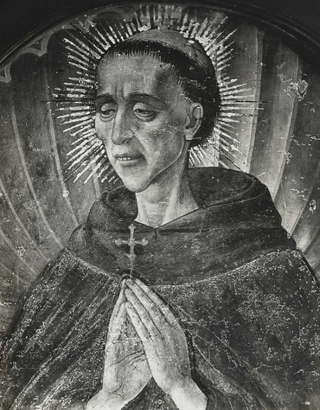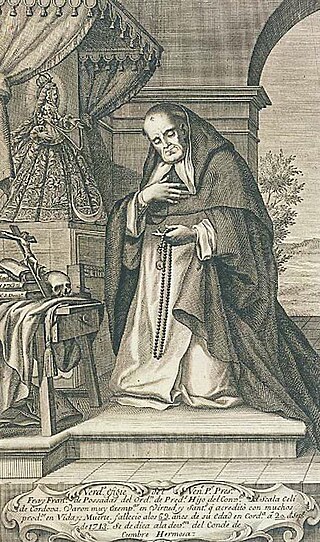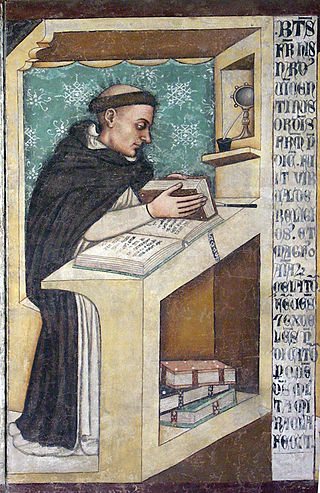Giovanni Battista Righi was an Italian Roman Catholic priest and a professed member from the Order of Friars Minor. He was known for ascetic life and for his preaching and healing abilities.

Angelo Agostini Mazzinghi, O.Carm was an Italian Catholic priest and Carmelite friar. He was a noted preacher from Florence and was known for his pious devotion to the Carmelite Rule and to the spread of the gospel.

Andrea Bertoni was an Italian Roman Catholic priest and a professed member of the Servite Order. Bertoni assumed the religious name of "Giacomo Filippo" upon being admitted to the Servites and he became the procurator of the convent he lived in from his appointment until his death.

Baldassare Ravaschieri, OFM was an Italian Catholic priest and a professed member of the Order of Friars Minor. Ravaschieri served as a noted preacher and confessor and befriended as contemporaries Bernardine of Feltre and architect Giovanni Antonio Amadeo.

Luigi Rabatà, O.Carm was an Italian Roman Catholic priest from the Order of Carmelites. He served as prior of his convent of Randazzo until his death which occurred after an attack in which an arrow was shot into his head.

Bernardo Scammacca, OP was an Italian Catholic priest and member of the Order of Preachers. After leading a dissolute early life, his conversion after a sustaining a wound from a duel led him down the path toward religious life. He became a noted prophet and spent hours in the confessional.

Domenico Spadafora was an Italian Roman Catholic priest and a professed member of the Order of Preachers. Spadafora was a noted evangelist and attracted countless to the Dominican fold while also converting the hearts of others who led dissolute lives. He is best known for being the first superior of a church he oversaw construction of in Monte Cerignone after receiving the papal approval of Pope Alexander VI to commence such work.

Ugolino da Gualdo Cattaneo was an Italian Roman Catholic professed religious and friar of the Order of Saint Augustine. Ugolino is best known for founding an Augustinian convent in Gualdo Cattaneo in 1258 where he served as its prior until his death. He practiced a rigorous spiritual life with austerities including frequent bouts of strict silence and fasting.

Francisco Martín Fernández de Posadas was a Spanish Roman Catholic priest and a professed member of the Order of Preachers. He became a noted preacher and popular confessor while being hailed as a second Vincent Ferrer and in the beginning was subjected to violent dislike and ridicule from fellow Dominicans before he was allowed to enter the order.
Rinaldo da Concorezzo was an Italian Roman Catholic priest and archbishop who served as the Bishop of Vicenza from 1296 until his 1303 appointment as the Archbishop of Ravenna-Cervia holding that until his death.

Guala de Roniis was an Italian catholic priest and a professed member of the Order of Preachers as one of Dominic of Osma's earliest disciples. De Roniis was born as a noble and was appointed as the Bishop of Brescia after Dominic's death though also served as a popular papal legate that earned him popular and papal support. He resigned from his episcopal see to dedicate the remainder of his life to peaceful solitude though his reputation for personal holiness prompted countless people to seek him out for his counsel.
Giovanni de Surdis Cacciafronte was an Italian Roman Catholic priest and bishop from the Order of Saint Benedict. He served as the Bishop of Mantua from 1174 until his resignation in 1177 and held the position of Bishop of Vicenza from 1179 until his murder. The schism that Antipope Victor IV caused enabled him to proclaim his support for Pope Alexander III though leading to his removal from a position at the behest of Frederick Barbarossa.
Elena Valentinis was an Italian Roman Catholic professed religious from the tertiaries of the Order of Saint Augustine. Valentinis was born to nobles and married a knight during her adolescence while mothering six children before she was widowed in 1441. She soon became a professed religious and dedicated herself to austerities and a life of complete penance.
Giovanni da Penna was an Italian Roman Catholic priest and a professed member of the Order of Friars Minor. He became a Franciscan in 1213 after hearing Fra Filippo - one of the disciples of Francis of Assisi - preach. He spent over two decades in France where he oversaw the establishment of Franciscan houses before returning to the Italian peninsula where he served his life in quiet cloistered retirement.
Antonio da Stroncone was an Italian friar of the Order of Friars Minor. He became a member of that order in his youth after cultivating a strong devotion to Francis of Assisi during his childhood with his parents who were members of the Third Order of Saint Francis.

Gregorio Celli was an Italian priest of the Roman Catholic Church and a professed member of the Order of Saint Augustine. Celli lived with the latter order in Rimini until he decided to spend the remainder of his life in deep contemplation and so moved to the region's hills where he dwelled in a cave near the Franciscans stationed there. It is claimed he was expelled from his order and became a Franciscan though there is no evidence to support this claim.
Blessed Hartmann of Brixen was a German prelate of the Catholic Church, who served as the Bishop of Brixen from his appointment in 1140 until his death. Hartmann served alongside the Order of Saint Augustine - who oversaw his education - and he managed certain aspects of their order despite not being part of that congregation. He also supported Pope Alexander III during his struggle with Frederick Barbarossa and also earned the favor of the latter despite Hartmann's views of the schism.

Bartolomeo Fanti was an Italian Roman Catholic priest from the Carmelite order in Mantua. Fanti served as the spiritual director and rector of a religious movement in his hometown and oversaw the establishment of their rule and statutes while himself serving as a novice master for his own order where he became known for being an effective preacher.
Antonio Pavoni, OP was an Italian Catholic priest and member from the Order of Preachers. He served as an inquisitor-general for Pope Urban V in combatting Waldensians in the Lombard region, but the Waldensians succeeded in killing him in an ambush as he preached an Eastertide homily in 1374.

Isnardo da Chiampo, OP was an Italian Catholic priest and professed member in the Order of Preachers.












